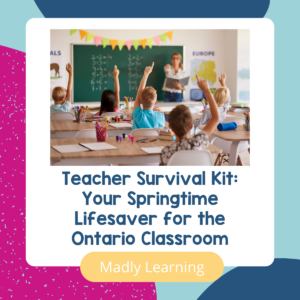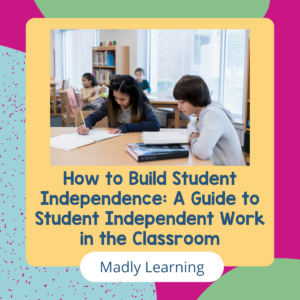Failure…
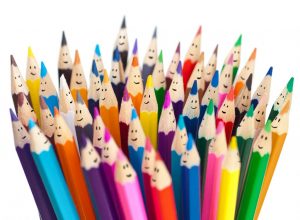
Too many students are afraid to fail, and this often prevents them from even trying in the first place. They don’t know how to do it and don’t know how to manage the frustrations that come along with failing. Perseverance and self-reflection is a skill that many of my students struggle with immensely,
However most often failure is used as the ultimate motivator or a scare tactic.
But what if using failure as a scare tactic we used it to help our students develop more of a growth mindset and used it to teach them how to take risks.
Learning is a journey that starts with not knowing how to do something to learning how to do it.
It reminds me of teaching my kids how to tie their shoes. For a while, I would just do it for them or simply buy them shoes without laces. By avoiding the problem, I avoided that frustrating part where they cried because they couldn’t do it, begged me to do it for them and were just annoyed that I wouldn’t just buy them more velcro shoes.
But learning how to tie our shoes is an essential skill that all humans, if capable, should master. So my kids had to go from not knowing how to do this independently. The process involved showing them how, making them practice until they learned it. But this also means that there were a lot of failures and frustration.
Like many kids, they simply didn’t do this on the first or even hundredth try. This learning process also required me to hold the belief that they could do this and that through my patience and support of trying again and again, eventually, they would get it and be successful.
This is also what learning looks like in my classroom each and every day.
So knowing this was a problem I asked myself
- How do I help students to learn that failure is part of learning how to do something?
- How do I help them to understand that how to fail and overcome failure is an essential skill?
Diagnostic Assessments
The first thing I noticed that made a difference was talking about it.
I found that it was essential to address that failure was a part of learning. That the first time something was tried, students shouldn’t expect it to be easy. But that they should take this opportunity to decide what they needed to do next and where they were going to learn going forward.
At the beginning of a learning unit, we complete a diagnostic assessment. This is a test that allows the teacher to understand what students know and what they don’t know. This task is often frustrating for students. However, it is essential to set both themselves and you up for success.
You, as the teacher, know where they are, and they, as students, can only go up from their own frustrations that this task can induce.
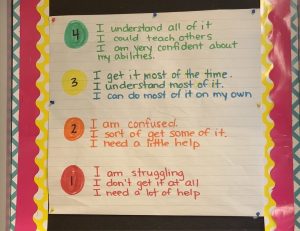
Self Reflection
Check-Ins
Now that students understand what they need to do to move forward, and where they are on the continuum of learning, another vital opportunity is to get students to self asses their own knowledge.
To do this, co-create a modified stoplight system.
Green – I am confident with my knowledge. I fully understand
Yellow – I understand most of it. I feel good about my knowledge
Orange – I understand some of it. I still need help but know and do a few things correctly
Red – I am struggling to understand it. I need a lot of help to know what to do.
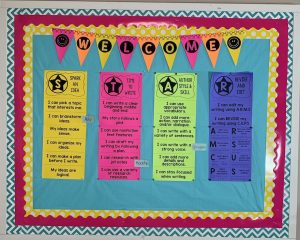
Goal Setting
Help students to define their next steps in their journey. For the subjects that you are teaching, create a list of goals that will help them improve within that subject area. Then post these goals within your classroom. Then when conferencing with students helps them to determine the skill that they most need to work on to show improvement.
This is an example of my goal board within my literacy programs
Students use this during student-teacher conferences and tell me what it is they are going to be working on next. During these conferences, students will get feedback from me as to what they need to improve. Then they will set a goal to make these improvements.
Celebrate Failure
One of the easiest ways to show students that failure is okay and part of the journey is to focus on the scars of failure and not the wounds. Now, this is an analogy that I learned on another podcast. However, it can apply to education and what you do in your classroom.
Kids who are afraid to fail may feel this way because they fear the consequences of failure. Feeling like a failure isn’t the goal. It is teaching kids to work through hardships and persevere through painful learning experiences.
So to focus on the wounds means you are focusing on the failure at the point of failure. This is when it is messy and doesn’t feel right. Instead, work with students to point out the scars that failure leaves behind when they have distance from it. Focus on the positive outcomes of failure.
This often happens in my class during math. At times I will give my students a new version of their morning math page. This page is differentiated to allow the diverse learners in my classroom multiple entry points. It is also a page that is repeated daily, and the parts that change are the numbers that they are working with.
If I were to focus on the wounds, I would be focusing on their frustrations at the moment. Instead, I focus on the scars and remind them of the last time I changed the page and how they felt. Then I challenge them to remember how they felt a few days after that when they had mastered the skill and concept and learned the lesson we were trying to achieve.
Though this example, I am focusing on the past event that they overcame and reminding them that they can do hard things.
We will also use these as examples of their progress. With student permission, I will use exemplar students who might often not be in the spotlight to celebrate their perseverance and ability to overcome hardship. This highlights for other students that failure is not the end of the line that there is a way out and a place to go.
The only thing worse than failure is not trying at all.
 Feedback and Assessment
Feedback and Assessment
Students need to know from us as teachers where they are and where they are going.
They need to know what the measurement stick looks like when it comes to assessment.
They can’t improve if they don’t know where they are and where they need to go.
For this reason, feedback cycles and conversations with students on where they are and what they need to work on are essential components of all parts of the subjects that you teach.
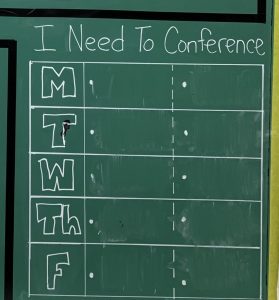 In writing, I schedule a time to meet with the student and assess where their skills are as a writer. I use the curriculum expectations along with the success criteria developed within my literacy program to help me facilitate this conversation.
In writing, I schedule a time to meet with the student and assess where their skills are as a writer. I use the curriculum expectations along with the success criteria developed within my literacy program to help me facilitate this conversation.
Together we discuss what good writing looks like and create levelled texts to include on a “Bump It Up” poster that hangs in our classroom. On these levelled texts, we cover the ideas made by students on the differences between the versions.
Students can regularly compare how they did on their writing with that of the example texts. This allows them to know how they measure up in their skill level and tells them exactly what they need to do moving forward if they want to improve their mark.
In the past, I have used my bump it up boards in a variety of subjects such as Reading Responses, Fiction/Non-Fiction Writing, Math Problem Solving and Inquiry Projects. They have been massive on a big bulletin board, portable on a trifold board, or simply just on a piece of chart paper. Regardless of how it is displayed, it helps students to better understand how to measure their success.
Be Careful
Failure is essential, but these are the little failures along the way that the student can overcome. These are not setting a child up for a situation where they will not reasonably be able to meet the targets that are being set.
Teachers need to have high but reasonable expectations of students’ abilities.
It is also essential to focus on the way a student bounces back and overcomes failure more than the failure itself.
Learning needs to be worth the risk of falling down and failing. Students need to understand that through their hard work, perseverance and grit students can work through and overcome the hardships of failure.
This is the world they are living in – life isn’t perfect, failure is inevitable, and hard work is necessary.
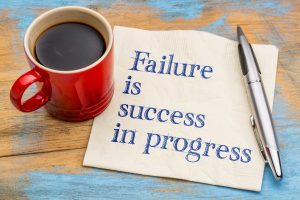

Want to hear more from Patti? Check out her blog or find her on Facebook and Instagram!

